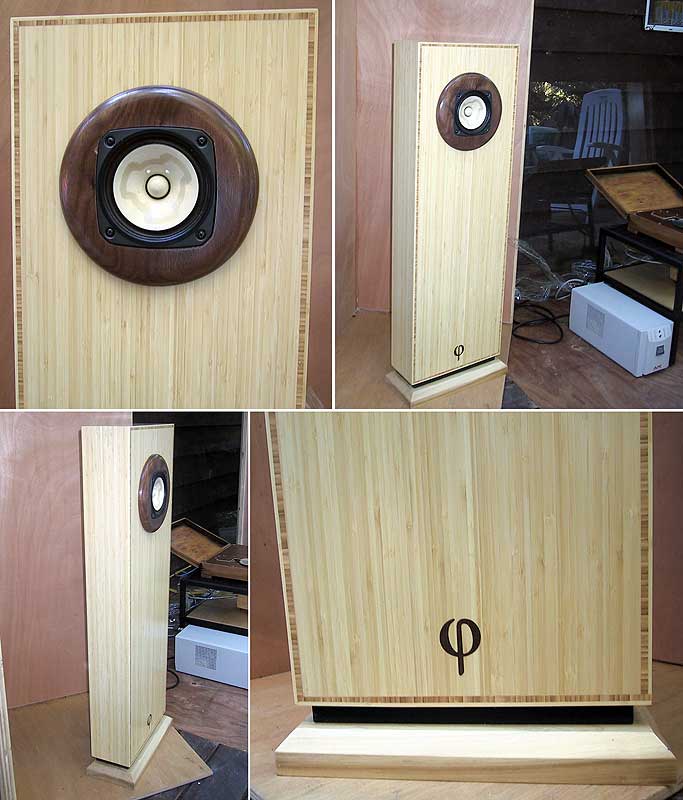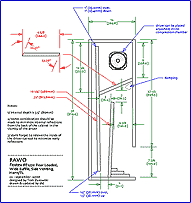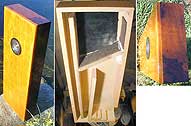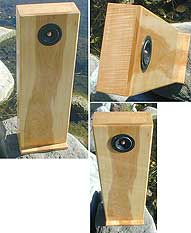|
Tom Zurowski PAWO
Rear Loaded, Wide Baffle, Side
Venting Horn/TL

| |
|
|
| |
Update: The Fostex FE127 works in this box. And works VERY
well. so i've moved this to the Fostex section...
A number of builds
of this design have shown that it is not ready for prime time and cannot be recommended
as designed. There is a closed in, colored midrange character that overwelms any
positives.
It is believed that the compression chamber volume is too small, but this has not
been verified. The design concept is just too cool to just remove it. Hopefully someone
will experiment with the design and get it to work
1st approximation of a fix would be to increase the depth of the compression chamber
by 3/4" (19mm). Alternately some height could be added to get more CC.
There have been reports that the FE126 works in this -- we tried that and although
a bit less it still suffered the same problem. We tried driver after driver, and
finally tried the FE127e and the rest is history.
dave |
|
| |
|
|
|

Sheet 1 -- Enclosure Plans

Tom's original prototype boxes

A set in solid
|
|
The FR125S is a smooth, detailed,
spacially accurate driver that can successfully cover the full range from treble
to bass. The FR125S is especially successful at conveying musical emotion as
communicated by the gradiations of soft and loud dynamic nuances. This driver along
with the Jordan JX92S are my favorite two drivers, especially suitable for small
to medium sized rooms with medium sized amplifiers. Compared to other speakers noted
on this web site, the character of these drivers seems to be more laid-back in nature,
without any upper midrange prominence. In the "Pawo" cabinet, the bass
is very robust, yet without a midbass emphasis.
***The following experiences have been employed in the design of FR125S "PAWO"
speaker cabinet.***
THE HORN PATH: A longer path makes for a deeper roll off, a deeper emphasis in the
bass. Think of the slide of a trombone. It is doubtful that rounded curves in the
path make a difference, since the sound waves are long & wide bass frequencies.
THE HORN MOUTH (THE VENT): A bigger mouth makes for a louder bass. But if the mouth
is located near the floor, side wall or back wall, these junctions become part of
the mouth.
THE MOUTH'S POSITION: If venting to the rear, the bass is reinforced by the back
wall, but if the speaker is too far out from the wall, the bass can sound disconnected
and distant. If venting to the front, there are phase problems that are heard as
blurred midbass when the drivers front and rear (after passing through the path)
wave are propagated together. If venting to the side, there is a compromise that
can make use of side or back walls; this is my preferred position.
THE CHAMBER BEHIND THE DRIVER: If the chamber is shallow, as in all Fostex designs
as well as the Jordan VTL, much of the treble can bounce back through the driver,
so some damping material is called for. If the chamber is deep, more of the midrange
can bounce back. I've tried a funnel shape as a compromise, but now think that the
shallow chamber with damping material might be best. The sound bouncing around in
this chamber does come back out through the driver (unless the driver is mounted
in an open baffle), and this sound takes on the shape of the chamber, sometimes with
musical image that is often described as boxy. Presently, I like a shallow &
wide chamber with little, if any parallel sides. If little damping material is used
the sound is bright and lively, or if much damping is used, dull; thus the amount
must be adjusted to match the sound of the amplifier etc.
THE BAFFLE: The baffle to which the driver is mounted can be narrow or wide. Having
employed a couple of drivers into extremes of both, I hear a narrow baffle as projecting
a more precise image location, but if the speakers are not located well away from
side and back walls (more than a yard), the melodic line suffers. It suffers because
the musical pitches are distorted as they reflect from room furnishings. Thus I prefer
a wide baffle of at least a twelve inches. With a wide baffle, musical pitch is more
stable--especially true of center stage sounds that emanate from both stereo speakers.
With a wide baffle, the music comes through smoother, more accurate, easier to listen
to. With a wide baffle more of the sound energy is directed to the listener, thus
the volume control can be turned down a notch. Finally, with a wide baffle, room
positioning is not very critical, allowing for placement very near to a rear wall.
~Tom Zurowski
(editor note: this
is one of our standard bespole enclosures) |
|

